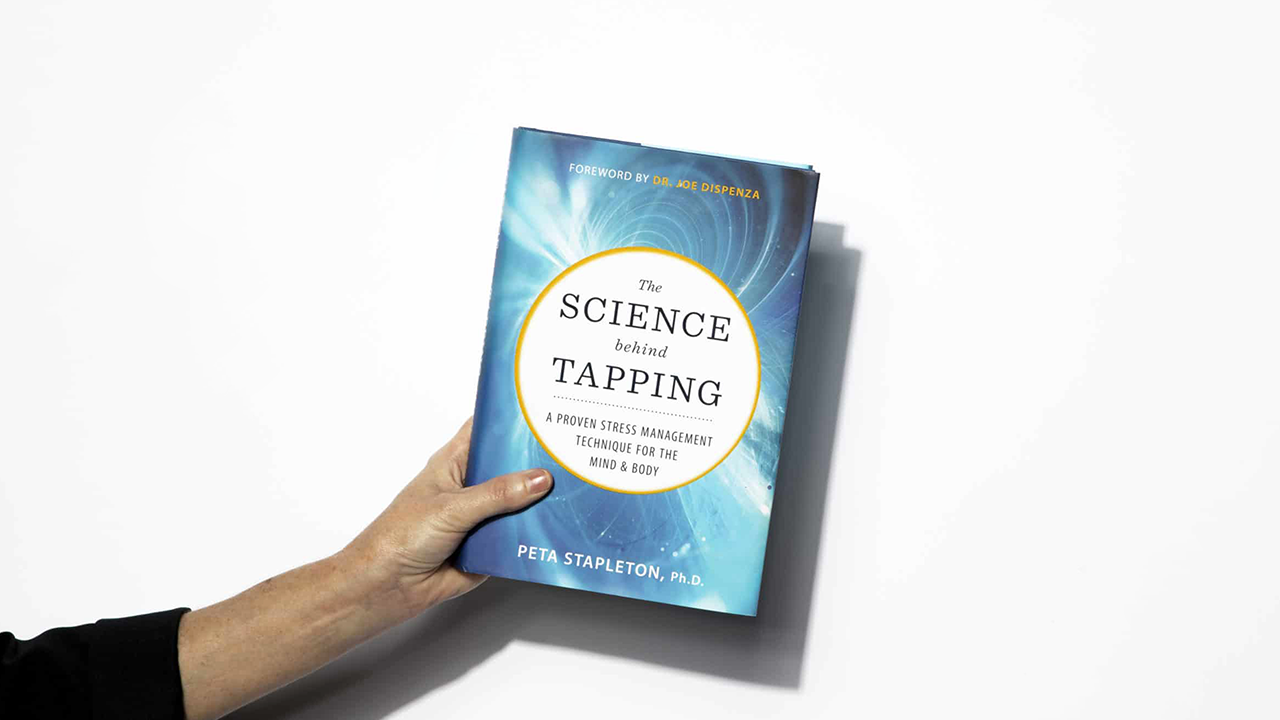The Science Of Tapping

A 3 Part Video Series with Dr. Peta Stapleton
This 3-part series from world leading EFT researcher Dr Peta Stapleton takes you on journey into the science of EFT so you can more easily understand and share the evidence. Access the series now at Evidence Based EFT.

The Science Behind Tapping Book
Published by Hay House in 2021,The Science behind Tapping, come away with a deeper understanding of what EFT is and how it can help you.

The Science Behind EFT Tapping
A Proven Stress Management Technique for the Mind and Body
EFT Tapping researcher and author Peta Stapleton, Ph.D., brings together the history and cutting-edge research of tapping. She also shows how tapping can be used for a whole host of ailments, including anxiety, weight issues, depression, trauma, and more. Dr. Stapleton’s own groundbreaking study involving food cravings in overweight adults helped establish EFT as an effective, valid form of therapy.
In The Science behind Tapping, you’ll come away with a deeper understanding of what EFT is and how it can help you. The book starts with a beginner’s guide to EFT, which includes tapping statements and phrases, as well as helpful charts showing the location of tapping acupoints on the face and upper body. After taking you through its many uses, Dr. Stapleton also explores the common obstacles to success with EFT, and how to combat them.
Hard Copy Book
Order now through links below (or your favourite book store).
Available in hardcover, paperback and kindle at
Audio Book
If you prefer audiobooks and love a good listen, then The Science Behind Tapping is available on Audible. Recorded in my own voice (I’m an Aussie!), listen in your own time. It is available in every country through Audible and free 7 day trials are available if you do not have an account.
Purchase Now at AudibleFeatured Research
World First fMRI Study of EFT

Early findings from a world-first study aimed at scientifically proving a simple ‘tapping’ technique have shown the method is effective in reducing food cravings. This is the first time anywhere in the world that Functional Magnetic Resonance Imaging scans (fMRI) have been used to see physical, scientific evidence of exactly how EFT self-help techniques work on these conditions by changing the brain’s neural pathways involved in addiction and food cravings. After 4 weeks (2 hours per week) of EFT Tapping, participants’ brain scans showed a remarkable reduction in activation. The control group who did not receive any EFT did not change. The full paper and scans are available below.
An Initial Investigation of Neural Changes in Overweight Adults with Food Cravings after Emotional Freedom Techniques
Recommended citation: Stapleton P, Buchan C, Mitchell I, McGrath Y, Gorton P, Carter B. An Initial Investigation of Neural Changes in Overweight Adults with Food Cravings after Emotional Freedom Techniques. OBM Integrative and Complementary Medicine 2019;4(1):14; doi:10.21926/obm.icm.1901010.
Abstract
Background: This pilot randomised clinical trial investigated the effect of Clinical Emotional Freedom Techniques (EFT) on brain activation in response to food craving stimuli using functional magnetic resonance imaging. EFT is a brief stress reduction technique which involves stating a cognitive statement with stimulation of acupressure points with a tapping technique.
Method: Fifteen overweight/obese adults were allocated to a four-week group EFT treatment or control condition and completed a measure of food craving. Random repeating images of high-calorie food designed to engage parts of the brain were presented during the pre and post fMRI scans.
Results: The Group x Time interaction for food cravings were significant for the EFT group when compared to the controls. Participant mean scores decreased by 18% for the EFT group and 5% for the control group. Brain activity was mapped using fMRI measures, and there was relative deactivation in the Superior Temporal Gyrus and lateral orbito-frontal cortex for the EFT treatment group only. The control group however, showed continued activation in these areas.
Conclusion: The findings indicated EFT may decrease limbic region brain activity and reduce food related symptoms in overweight/obese individuals. This study also illuminates the neurological mechanisms at work behind the many successful outcome studies of EFT for weight loss. Read full article here.
Featured Research: World First fMRI Studies of EFT
Chronic Pain
Recommended Citation: Stapleton, P., Baumann, O., O’Keefe, T., & Bhuta, S. (2022). Neural Changes after Emotional Freedom Techniques Treatment for Chronic Pain Sufferers. Complementary Therapies in Clinical Practice, 49, https://doi.org/10.1016/j.ctcp.2022.101653
This clinical trial investigated the effect of an Emotional Freedom Techniques (EFT) intervention on brain activation in chronic pain sufferers using functional magnetic resonance imaging (fMRI). EFT is a brief stress reduction technique which combines stating a cognitive statement with somatic tapping on acupressure points.
Twenty-four adults were allocated to a six-week online group EFT treatment and underwent resting-state fMRI pre and post the intervention. A repeated measures MANOVA indicated significant differences in the levels of pain severity (−21%), pain interference (−26%), quality of life (+7%), somatic symptoms (−28%), depression (−13.5%), anxiety (−37.1%), happiness (+17%), and satisfaction with life (+8.8%) from pre-to post-test. Cohen's effect sizes ranged from small (0.2) to large (0.75) values suggesting significance for the intervention.
fMRI analysis showed post-EFT treatment significantly decreased connectivity between the medial prefrontal cortex (a pain modulating area) and bilateral grey matter areas in the posterior cingulate cortex and thalamus, both areas being related to modulating and catastrophizing of pain. There were no brain areas that showed significantly increased connectivity post-EFT treatment.
Coupled with the psychological measures the findings support the effects of the EFT intervention in reducing chronic pain and its impacts. Recommendations for future research are discussed.
The paper is available to read here https://research.bond.edu.au/en/publications/neural-changes-after-emotional-freedom-techniques-treatment-for-c

The blue colour means less connectivity (originating from the medial frontal gyrus) to those regions after EFT
Growth and Acceptance of EFT
- As of 2020: 18 randomised control trials, 50+ randomised control trials, 50+ pre-post outcome studies, 50+ trials in non-English journals
- 2014–2016: 2 meta-analyses show energy psychology effective for depression and anxiety
- 2017: Meta-analysis shows EFT effective for PTSD
- 2019: Meta analysis shows tapping on the acupressure points is an active ingredient in the process (changes not due to the therapeutic relationship, other factors such as deep breathing etc)
- 2018-2019: Two studies on DNA changes after EFT First fMRI study on EFT published
- 2019: Blue Knot Foundation for (trauma) includes EFT in PTSD clinical guidelines in Australia
- 2020: EFT approved under the National Insurance Disability Scheme NDIS) for therapy in Australia 2020: Australian Psychological Society features EFT during National Psychology Week as emerging approach for pain
- 2020: APA journal (USA) published EFT cortisol replication study
- 2020: A major review of psychological treatments for PTSD – Energy psychology (combined somatic/cognitive therapies) was the 2nd most effective at reducing PTSD symptoms at the end of treatment to waitlist (after EMDR which was found to be most effective). Further, energy psychology had the greatest cost savings over no treatment, followed by EMDR, trauma-focused CBT and then other treatments
- 2021: APA approved EFT to be reviewed for trauma and PTSD and inclusion on the evidence based psychological treatments list (Dr Peta is leading this evaluation for the APA)
Want to learn more about the Science of EFT?
EFT HQ is the world's largest online EFT Resource.
Deepen your EFT skills through Masterclasses, training and professional development based on the latest research in Clinical EFT.
Learn More